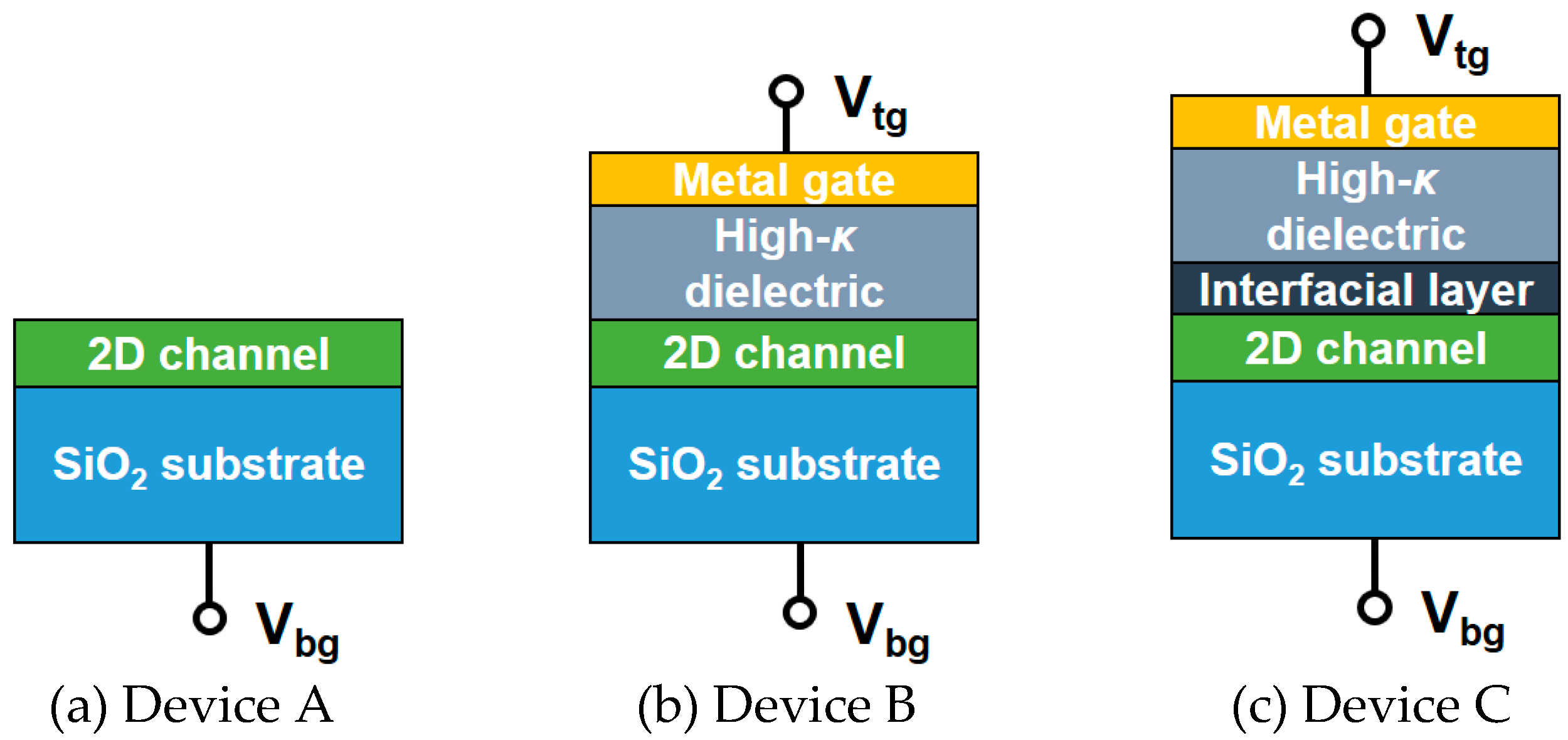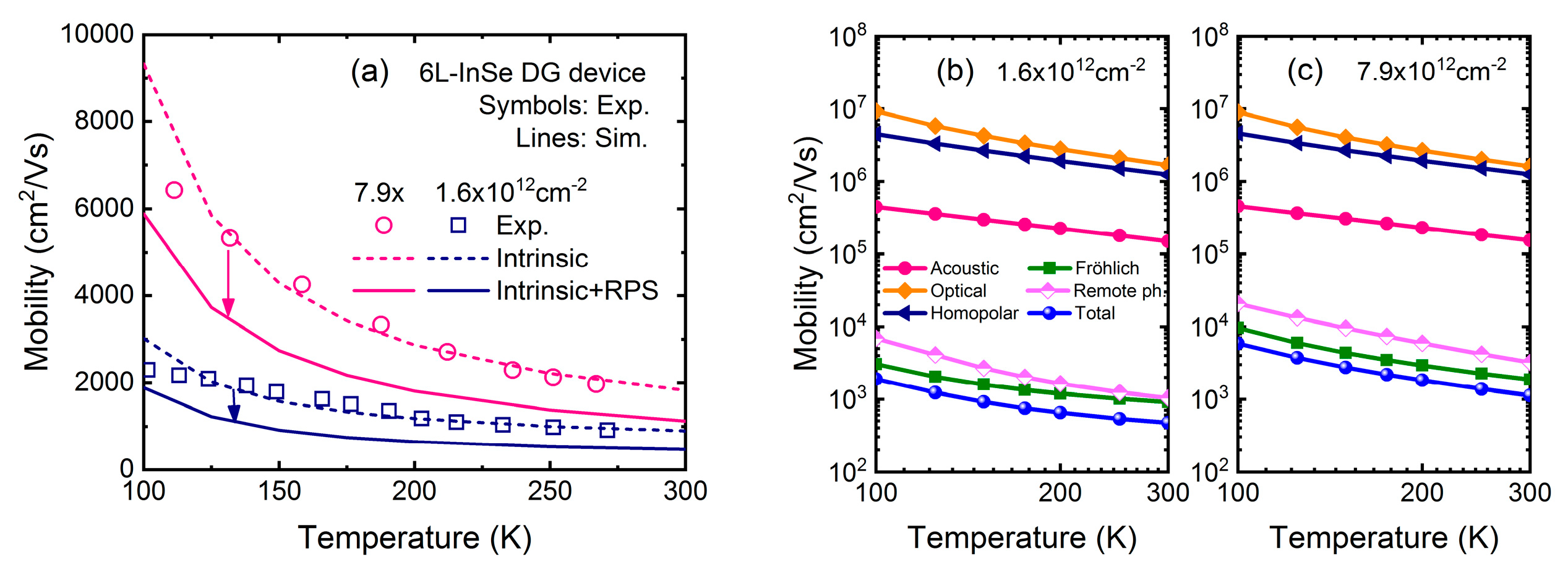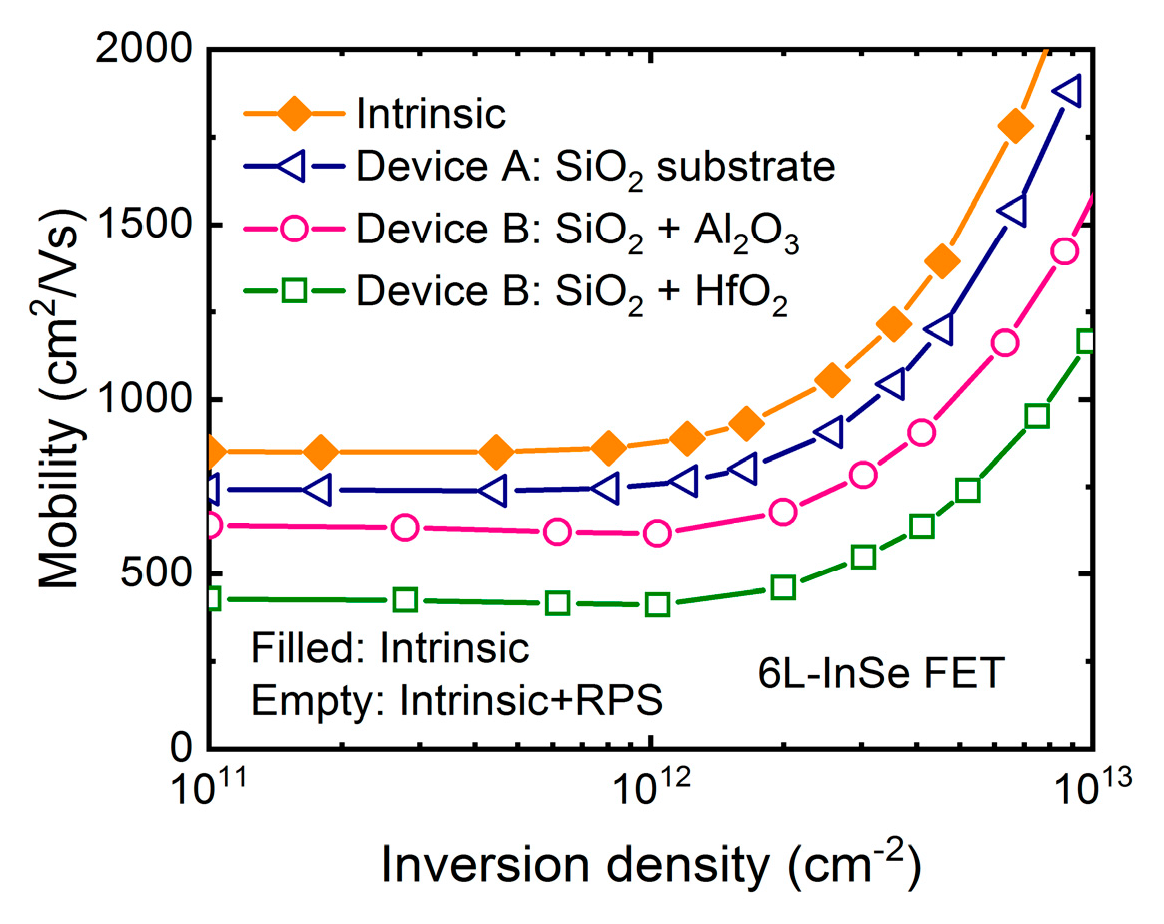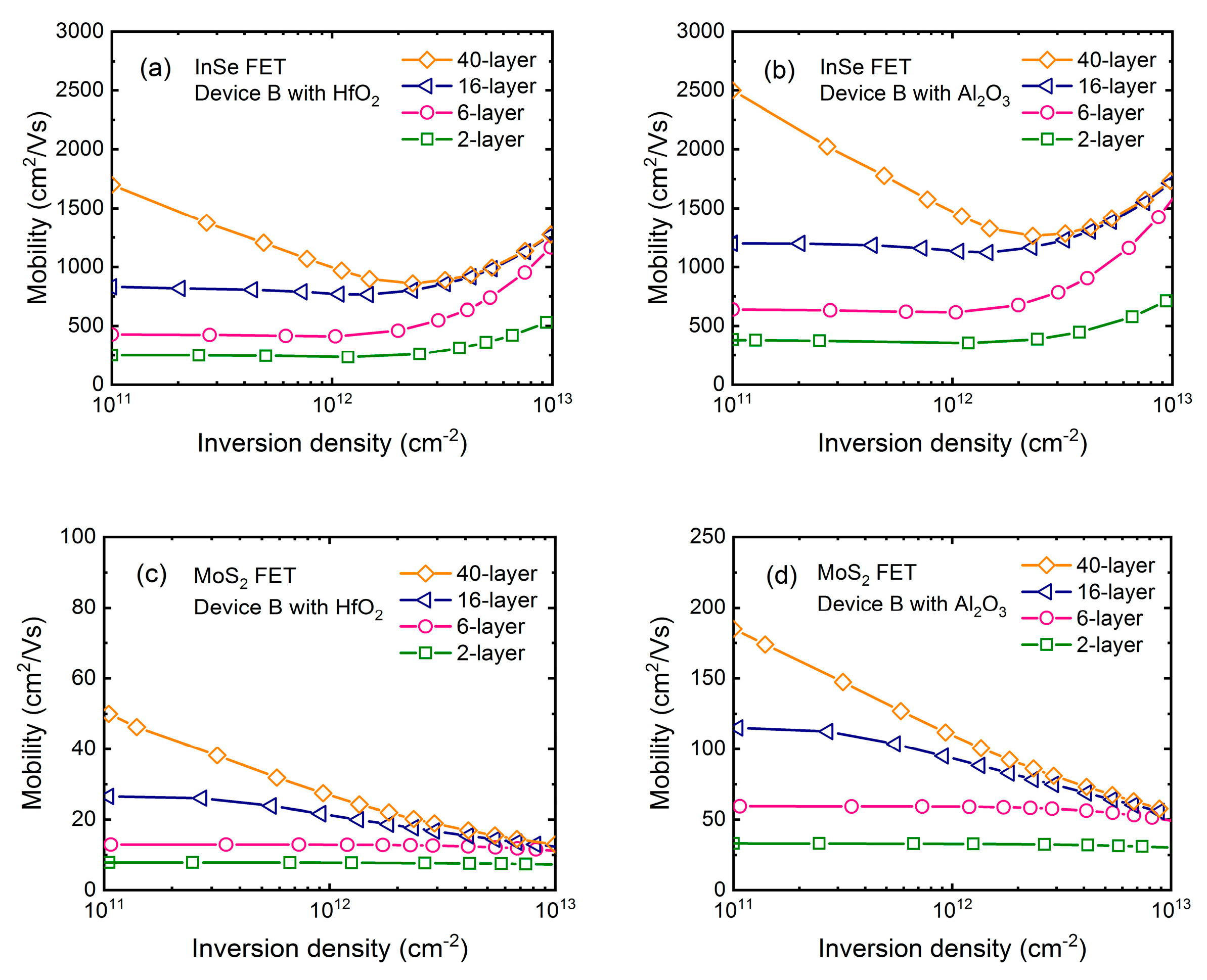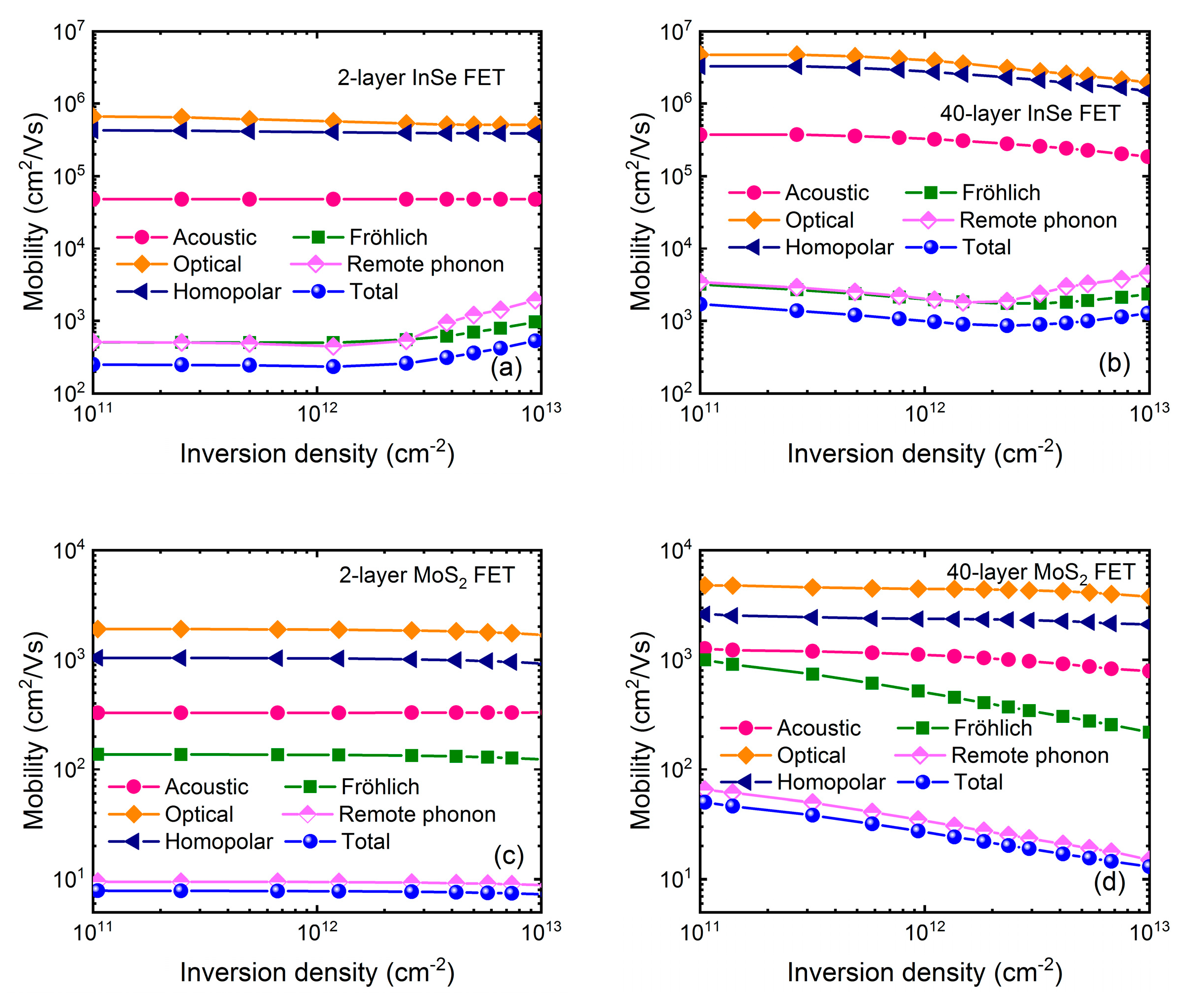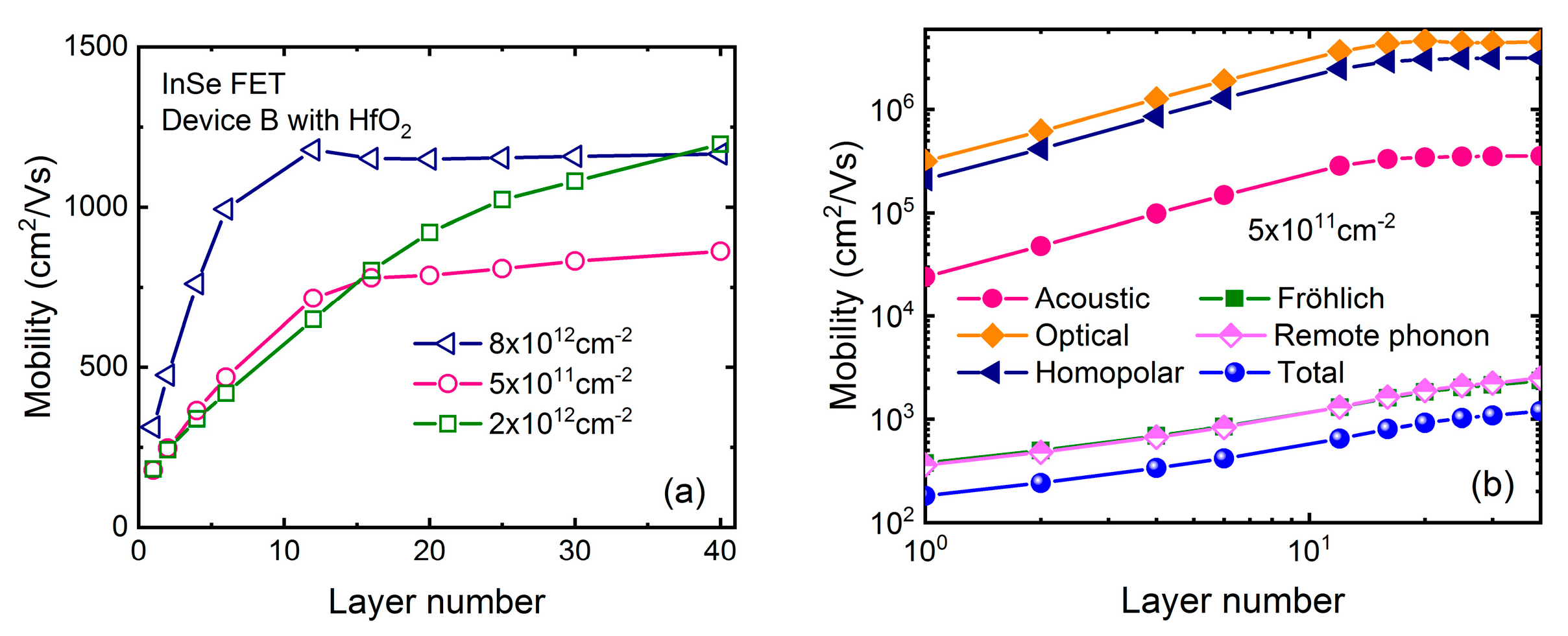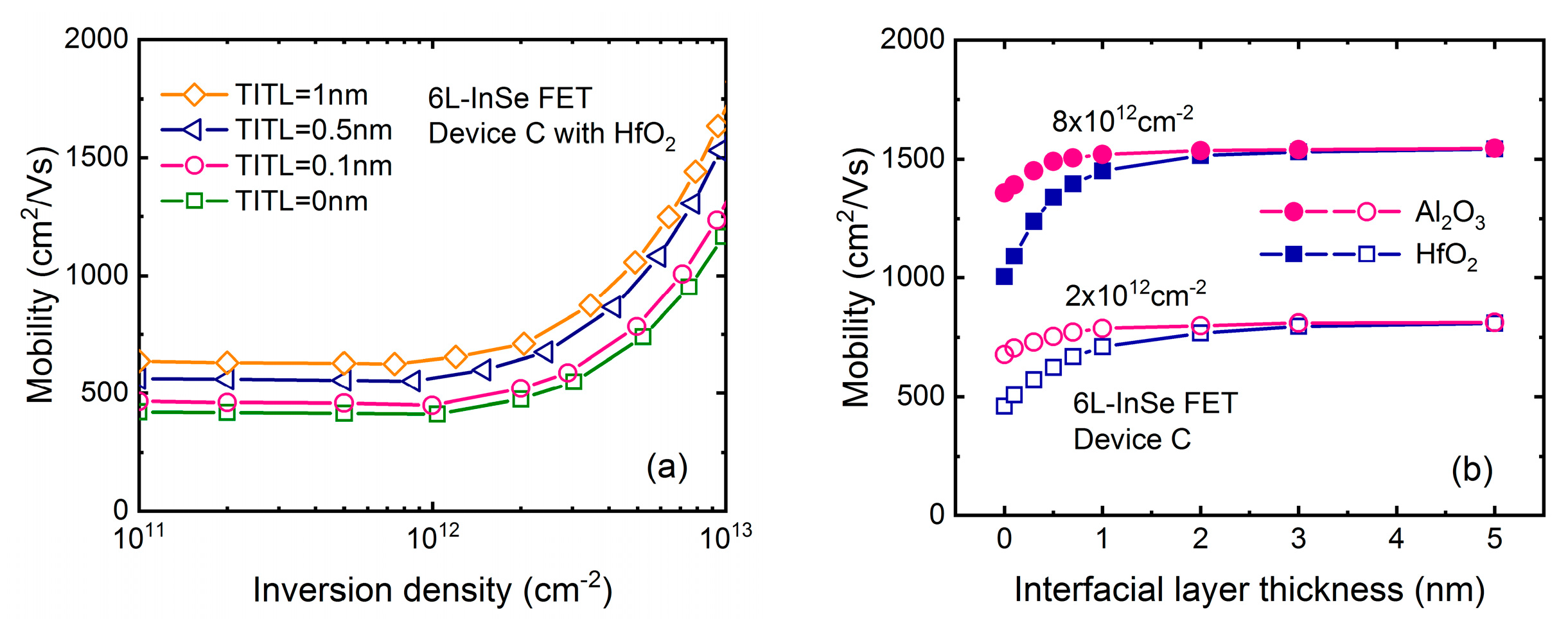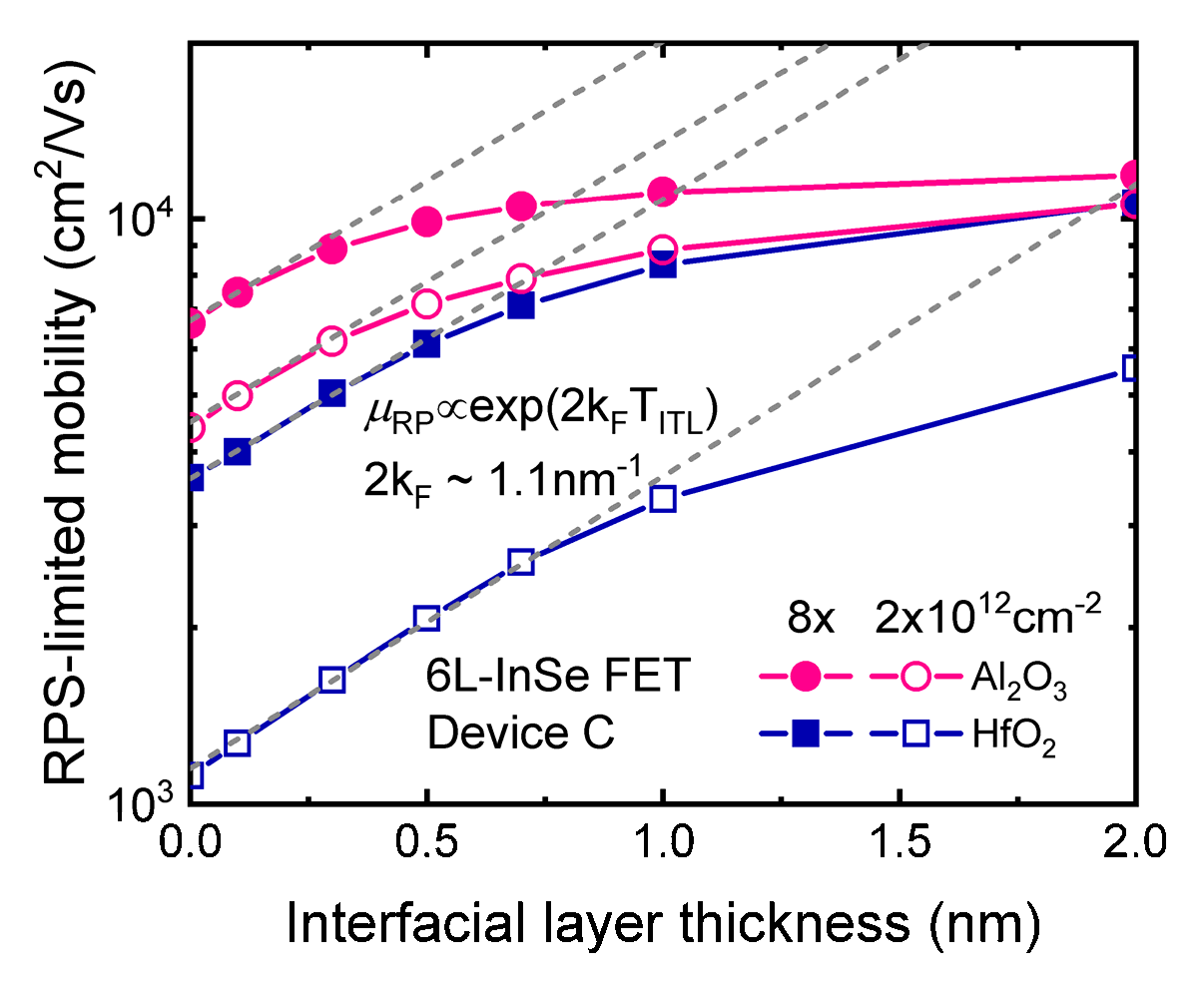1. Introduction
The compelling demand for higher performance and lower power consumption in complementary metal-oxide-semiconductor (CMOS) field-effect transistors (FETs) has highlighted the quest for devices and architectures based on new materials [
1]. Performance boosters such as strain, high-
κ dielectric, metal gate, and three-dimensional (3D) devices have enabled extraordinary improvement of performance in the past 60 years [
2,
3]. Recently, two-dimensional (2D) van der Waals semiconductors hold great potential for optics and electronics application due to their unique properties, including the atomic thickness, tunable bandgap, and dangling-bond-free surface, which achieves improved gate control over the channel and reduced short channel effects [
4,
5]. So far, many classes of 2D material-based devices have been extensively studied, such as graphene, transition metal dichalcogenides (TMDs), and black phosphorus [
6,
7,
8]. Very recently, few-layer InSe has attracted much attention due to its highly promising prospect as channel material for FETs, offering small effective mass of electron ~0.14
m0 and high electron mobility up to ~10
3 cm
2/Vs at room temperature obtained by experimental measurements [
9,
10,
11]. Therefore, InSe has advantages of a similar gap as silicon, 2D nature as graphene, higher mobility than TMDs, and higher environmental stability than black phosphorus. In addition, electrostatic tunability of spin-orbit coupling in InSe has been identified, showing potential in devising III-VI based spintronic devices [
12,
13].
However, the charge transport properties in InSe FET have not been well understood and starve for comprehensive investigation. More recently, the ballistic performance of mono- and multi-layer InSe FET is studied by the first-principles calculation and the top of the barrier model [
14], and temperature-dependent phonon-limited mobility is estimated by the physical modeling of intrinsic scattering mechanisms [
15]. On the other hand, charge transport behavior is very sensitive to external surroundings, such as gaseous adsorbates from air and trapped charges in substrates [
16], and their electronic performance is generally lower than their intrinsic values. Previous studies of back-gated multilayer InSe FET on various substrates (bare SiO
2, bare Al
2O
3, poly(methyl methacrylate) (PMMA)/SiO
2, and PMMA/Al
2O
3) have reported the carrier mobility ranging from 2.2 cm
2/Vs to 1055 cm
2/Vs at low operating voltage [
10], while dual-gated InSe FET on hexagonal boron nitride (hBN)/SiO
2 show an excellent mobility approaching 10
3 cm
2/Vs and 10
4 cm
2/Vs at room and liquid-helium temperatures respectively [
9]. It is apparently suggested that the introduction of substrate and gate dielectric has a strong effect on the electron mobility, which can be generally contributed to the extrinsic scatterings from surface roughness (SRS), interfacial Coulomb impurities (CIS), and remote phonon scatterings (RPS) [
17,
18]. Atomic flatness of 2D materials makes them immune to SR scattering, while CIS can be lowered or eliminated as possible by improving the fabrication process. Therefore, only remote phonon can be regarded as an intrinsic factor arising from the dielectric environment, and open questions remain as to its role in determining the electron transport in atomically-thin InSe FETs.
In this paper, the effect of remote phonons arising from the substrate and high-κ dielectric together with the intrinsic phonons of the InSe channel on electron transport is studied based on the physical modeling by self-consistently solving the Poisson and Schrödinger equations and employing the Kubo–Greenwood formula. Mobility behaviors in single-gate and dual-gate InSe FET with various gate dielectric are theoretically explored and analyzed as a function of temperature, inversion density, InSe layer number, and SiO2 interfacial layer thickness. Acoustic phonons and optical phonons—as well as homopolar phonons—have a minor effect on electron mobility, while remote phonons and Fröhlich interaction play a comparatively major role in determining the electron transport in InSe. Compared with MoS2, much smaller effective masses of electron in InSe give rise to a great enhancement of mobility at high density as carriers become degenerate. Simulation results in this work provide physical insight into the mobility behavior of InSe FET for carrier mobility optimization from the theoretical viewpoint.
This paper is organized as follows.
Section 2 describes the device structures and simulation methods, especially the physical models of remote phonon depending on the gate stack. In
Section 3, we present simulation results of mobility and corresponding explanations. Finally, the conclusion is drawn in
Section 4.
2. Device Structures and Simulation Methods
Simulated device structures with 2D-layered InSe channel are shown in
Figure 1, where the intrinsic channel without doping is assumed.
Figure 1a shows the back-gate (single-gate) InSe FET with SiO
2 substrate as gate dielectric.
Figure 1b shows the top-gate (dual-gate) InSe FETs with high-
κ dielectric as top dielectric and SiO
2 substrate as back dielectric.
Figure 1c shows the structure with additional SiO
2 interfacial layer (ITL) embedded between the InSe channel and high-
κ dielectric compared with
Figure 1b. In the case of single-gate devices, only the back gate is biased with V
bg, while the back gate is grounded and the top gate is biased with V
tg for the dual-gated devices. In this work, traditionally used high-
κ dielectrics of HfO
2 and Al
2O
3 are comprehensively studied, with corresponding parameters listed in
Table 1. Except for
Figure 2, all the simulation results are calculated at room temperature (300 K).
We start the calculation by obtaining the electrostatic characteristic of the two-dimensional electron gas (2DEG) in InSe layer by self-consistently solving the Poisson and Schrödinger equations using the effective mass approximation with nonparabolicity correction, inherently accounting for the quantum confinement effects [
19]. Particularly the energy dispersion of 2D-layered InSe is described by the thickness-dependent effective masses obtained from first-principles calculation, as shown in our previous work [
14]. Next, the matrix elements and the scattering rates are calculated through the Fermi golden rule [
19]. Physical models for electron mobility include the remote phonon scattering (RPS) arising from the high-
κ dielectric as well as the intrinsic phonon scatterings of channel material, including the acoustic (AC) phonon-, homopolar (HO) phonon-, optical (OP) phonon- scatterings, and Fröhlich interaction (POP) [
20,
21,
22,
23]. For AC phonons, elastic and isotropic approximations are adopted. The HO and OP scatterings are treated as inelastic and isotropic process. For POP and RP scatterings, inelastic and anisotropic characteristic are considered. Once the scattering rates are obtained, the mobility is calculated by the Kubo–Greenwood formula employing the momentum relaxation time approximation. The parameters for mobility calculation in few-layer InSe are taken from our previous work [
15].
For remote phonon induced by SiO
2 substrate, the semi-infinite substrate is assumed, and the dispersion relationship for the remote phonon model can be written as [
19]
where
ωTO1,SiO2 is the low-frequency phonon mode of SiO
2,
εInSe is the dielectric constant of InSe. The potential amplitude of the remote phonon is written as
For the remote phonon induced by top gate dielectric, high-
κ dielectric covered with a metal gate is employed in the simulation. As shown in
Table 1, the frequencies of two polar phonons in high-
κ dielectrics such Al
2O
3 and HfO
2 show great discrepancy. Hence, for simplicity, only the low-frequency phonon mode in high-
κ gate dielectric is considered [
19]. For high-
κ dielectric with a metal gate as shown in
Figure 1b, the dispersion relationship is
where
ωTO1,HK is the low-frequency phonon mode of high-
κ dielectric,
εHK,0 and
εHK,int are the dielectric constant at the static and intermediate frequency,
THK is the thickness of top gate dielectric, and
q = |
k −
k′| is the remote phonon momentum. The effective dielectric constant depending on the frequency dependent dielectric constant of the high-
κ material can be written as
and then the corresponding potential amplitude is
For the high-
κ gate stack with a SiO
2 interfacial layer, namely ITL/high-
κ/metal-gate stack as shown in
Figure 1c, the dispersion relationship is [
16]
where
TITL is the thickness of interfacial layer. The effective dielectric constant is
Then the potential amplitude for the ITL/high-κ/metal-gate stack can be obtained through the Equations (5) and (7).
3. Results and Discussion
To begin with, we calibrate the physical models with the experimental measurement.
Figure 2 shows the calculated and experimental temperature-dependent mobility at inversion density of 1.6 × 10
12 cm
−2 and 7.9 × 10
12 cm
−2 in six-layer InSe dual-gate FET. It should be noted that the experiment results are obtained from the dual-gate InSe FET with channel covered by hexagonal boron nitride (hBN) [
9], which insulates InSe from the dielectric environment, leading to the absence of remote phonon scattering. From
Figure 2a, considering the intrinsic scatterings by AC, HO, and OP phonon and Fröhlich interaction, the temperature-dependent electron mobility curves measured by Hall effect are reproduced successfully for T > 100 K, where phonon scatterings dominate. The excellent agreement between the simulations and experiments validate our methods and models. It should be pointed out that when temperature is down to 100 K, there is a significant discrepancy of mobility between simulations and experiments due to the fact that Coulomb scattering resulting from the channel impurities and interfacial charges is excluded, which is a dominant factor in determining the carrier mobility in the low-temperature regime.
On the other hand, if high-
κ dielectric of HfO
2 is directly deposited on the InSe channel, the mobility is severely degraded from its intrinsic value, as shown in
Figure 2a by solid lines. For example, at room temperature, mobility changes from 1808 to 1120 cm
2/Vs (920 to 464 cm
2/Vs) at inversion density of 7.9 × 10
12 cm
−2 (1.6 × 10
12 cm
−2) due to the remote phonon scattering. To understand the mobility behavior in depth,
Figure 2b,c plot the contributions of all the considered scattering mechanisms to the total mobility. Compared with AC, OP, and HO phonons, the remote phonon together with Fröhlich interaction plays a comparatively major role in determining the electron transport in InSe FET. This is the objective of this work to focus on the remote phonon scattering in InSe FET with high-
κ gate stack in the following.
The effect of remote phonon originating from the substrate and gate stack on the electron transport of few-layer InSe is shown in
Figure 3. The intrinsic phonon-limited mobility in six-layer single-gate InSe FET is ~843 cm
2/Vs at low inversion density. With SiO
2 substrate employed, the mobility is degraded to ~735 cm
2/Vs due to remote phonon. In the case of dual-gate structure, when Al
2O
3 and HfO
2 are used as top-gate dielectric, the additional remote phonon further reduces the mobility to ~634 cm
2/Vs and 426 cm
2/Vs respectively. It can be seen that the HfO
2 dielectric has a much stronger influence of remote phonon than Al
2O
3 and SiO
2 dielectric since it has higher dielectric constant and softer polar vibration mode [
20], as listed in
Table 1. Particularly, it is worth noting that the smaller permittivity of InSe results in a stronger remote phonon coupling with electrons compared with silicon even in the SiO
2 case. Despite serious degradation due to remote phonons, the mobility of the six-layer InSe with high-
κ dielectric is higher than that of silicon on insulator (SOI) device with SiO
2 dielectric at a comparative thickness [
24], revealing its great potential in high-performance logic application.
It is also observed that in six-layer InSe, mobility is increased significantly at higher density, which is against the common sense. To confirm this behavior, mobility in 2-, 6-, 16-, and 40-layer InSe FET is calculated in
Figure 4a,b, where HfO
2 and Al
2O
3 dielectric are used separately. At the same time, mobility in MoS
2 FET using same device structure is also plotted in
Figure 4c,d for comparison. In the MoS
2 case, as inversion density increases, mobility monotonously decreases for thick devices as expected, and remains almost unchanged for thin devices due to strong quantum confinement. In the InSe case, at low density, mobility behavior is consistent with MoS
2. However, when inversion density is larger than ~2 × 10
12 cm
−2, mobility quickly increases regardless of layer number or high-
κ dielectric. Actually, this is also demonstrated by experimental results in [
9] as shown in
Figure 2a, which cannot be totally contributed to impurity scattering because at large inversion density and room temperature the screening produced by the inversion layer drastically reduce the Coulomb scattering. Therefore, this exceptional enhancement seems intrinsic for 2D-layered InSe to a great extent.
To get physical insight into this mobility behavior,
Figure 5a–d shows the contributions of each scattering mechanism to the total mobility in both InSe and MoS
2 FET with 2- and 40-layer thickness respectively. Consistent with above-mentioned results, mobility behavior is mainly governed by the remote phonon and Fröhlich interaction in all considered devices. We find that their scattering rates increase with inversion density increasing, which should reduce the mobility. In the MoS
2 case, carriers are always non-degenerate following the Boltzmann distribution, where the mobility is essentially determined by the relaxation times or scattering rates. On the other hand, when inversion density is larger than ~2 × 10
12 cm
−2, carriers in InSe FET become degenerate, where subband minimum is lower than Fermi level
EF, and consequently the most influential relaxation times are those for energies close to
EF. Due to their anisotropic property, scattering rates of remote phonon and Fröhlich interaction are much smaller near
EF than those of the subband minimum, giving rise to an enhancement of mobility. This discrepancy between InSe and MoS
2 FET can be well understood by their effective masses. Firstly, in-plane effective mass of 0.14
m0 in InSe is much smaller than 0.62
m0 in MoS
2 [
25] leading to much smaller density-of-states (DOS). In order to obtain the same density, the conduction band minimum is lower than Fermi level over a few
kBT, where
kB is the Boltzmann constant. Secondly, quantization effective mass of 0.08
m0 in InSe is also much smaller than 0.49
m0 in MoS
2 [
26]. This is the reason that quantum confinement takes effect in 16-layer InSe, but not until the layer number is reduced to 6 layers in MoS
2. Actually, less subbands contributing to the carrier transport in InSe need Fermi level being higher to change the density, which makes carriers more degenerate together with the effect of small DOS.
The dependence of mobility on number of layer (NL) in InSe FET is shown in
Figure 6a, where inversion densities of 5 × 10
11, 2 × 10
12, and 8 × 10
12 cm
−2 are considered respectively. In the case of the relatively medium and high density, mobility is almost independent of channel thickness until NL ~15, and then drops rapidly as NL is further reduced. In the low-density case, mobility degradation occurs earlier when NL <40. It is noted that for thicker devices, mobility at 5 × 10
11 cm
−2 gradually surpasses the value at 2 × 10
12 cm
−2 and then reaches up to the value at 8 × 10
12 cm
−2. This awkward behavior can be explained by
Figure 4a,b, where mobility initially decrease and then the trend is opposite at higher density, as inversion density decreases in the 40-layer InSe FET. To get physical insight into the mobility degradation, contributions of each scattering mechanism at 5 × 10
11 cm
−2 is shown in
Figure 6b. AC-, LO-, and HO-limited mobility is severely reduced when NL is less than ~15, while the degradation of remote-phonon as well as Fröhlich-limited mobility begins to decrease about NL ~40, further indicating their major role in determining the electron transport.
Inspired by the similar situation for silicon [
27,
28], it is suggested that an interfacial layer can be introduced between InSe channel and high-
κ dielectric. To explore the effect of the interfacial layer,
Figure 7 shows the calculated mobility in InSe FET with device structure of
Figure 1c capped with different high-
κ dielectric. From
Figure 7a, it can be seen that the interfacial layer effectively insulates the channel away from the high-
κ dielectric, resulting in significant mobility enhancement in the whole range of inversion density due to weaker remote phonon coupling. As interfacial layer thickness is increased, more mobility enhancement is achieved until T
ITL approaches ~2 nm, when remote phonon from high-
κ dielectric is totally separated, as shown in
Figure 7b. Besides, a thin interfacial layer is more effective in HfO
2 dielectric compared with Al
2O
3 dielectric.
Figure 8 shows the corresponding remote coulomb scattering (RCS)-limited mobility as a function of SiO
2 interfacial layer thickness, showing an exponential dependence on T
ITL as
μRPS∝exp(2
kFT
ITL), whatever the inversion density or high-
κ dielectric is, with Fermi wavelength 2
kF = 1.1 nm
−1. This is in agreement with theoretical predictions for a remote scattering mechanism [
20,
28].
